How Fast Do Jacaranda Trees Grow – Jacaranda Annual Growth Rate
Jacaranda trees are fast-growing with minimum 3-4 feet increase in height. This can go upto 10 feet in some varieties in the initial years.
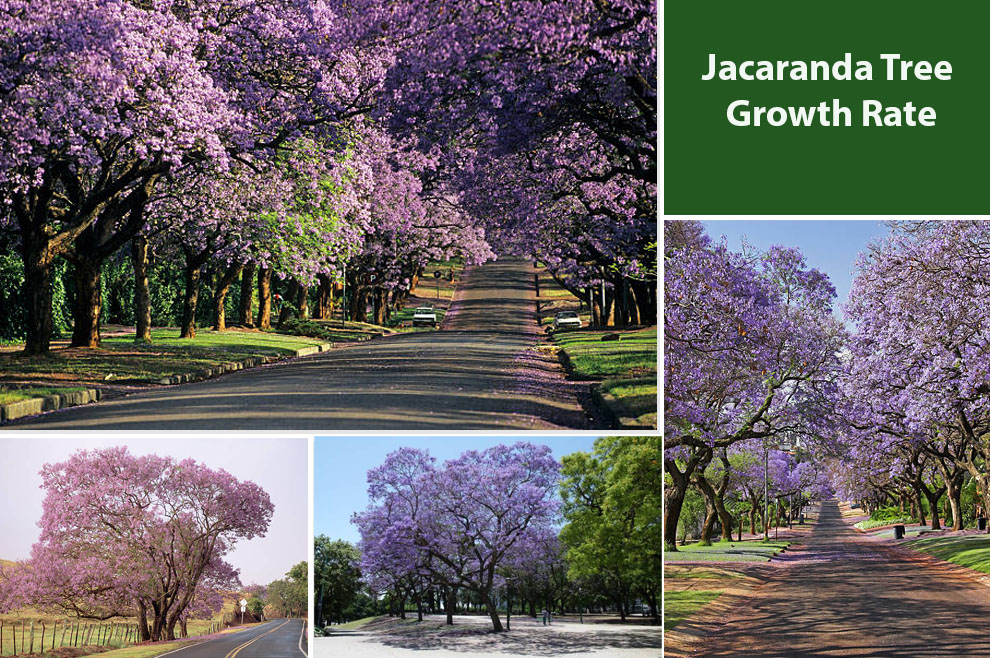
One of the most majestic tropical trees that everyone prefers to have in their garden is the Jacaranda tree. Also known as Jacaranda mimosifolia, it is a beautiful tree featuring a bunch of purple flowers which are panicle shaped.
You can enjoy the lovely shade and sweet fragrance of jacaranda trees from late spring through early summer. It makes excellent shade because of its broad leaves which can spread about 20 inches long forming a canopy.
The jacaranda tree growth rate may vary based on certain important factors like location, soil, temperature, watering needs, and more. Generally, they have a fast-growing and spectacular canopy-like structure that appears as an upside-down umbrella.
In the first few years of its life, some jacaranda trees see about 10 feet increase in its height, while others grow for 3-4 feet. However, if you plant it outside its perfect environment, it may see a slow growth rate.
How Fast Do Jacaranda Trees Grow?
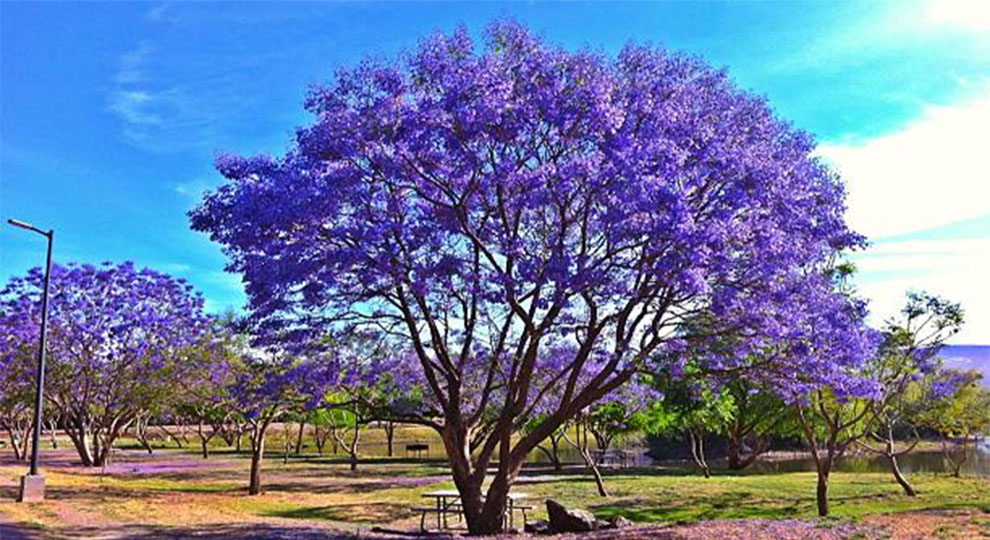
Typically, Jacaranda trees are grown between the fall to early spring seasons. These wonderful trees can be categorized as deciduous or semi-evergreen, based on the location and time when you plant them.
If it is planted in a tropical environment, the jacaranda tree growth rate per year can go up to 10 feet. This growth rate continues to be the same for the first few years. However, this does not apply to all the varieties. Some varieties show a growth of 3-4 feet every year. All jacaranda varieties have a fast growth rate, to say the least.
If you fail to provide optimal climate and tropical environment conditions to your jacaranda tree, its growth rate might slow down to moderate. For instance, jacaranda grows very well in some cooler areas, albeit rather slowly. Just take care to choose a location in which your plant stays protected from cold and heavy winds.
Furthermore, make sure to place your plant in soil that is well-drained and rich in nutrients. Jacaranda trees are happy to grow in any kind of soil except if it is overly sandy or waterlogged. In this case, however, you can boost your soil quality by adding optimal quantities of planting mix or compost.
Jacaranda tree blooms gorgeously on reaching the maturity phase, usually when it’s 8 years old or above. You can normally see its fragrant blooms from late spring through early summer months. However, if you live in cold winter regions, you can see it blooming at any time.
Is The Growth Rate Different For Different Varieties?
Jacaranda mimosifolia is a stunning tropical tree native to South America. Most of its varieties often attract people’s attention when placed in a front yard or garden. On top of this, it can be beautifully used for overarching a patio or driveway.
Most varieties of this tree are fast-growing and tend to last for a long time when taken care of properly. For specifics, how fast jacaranda trees grow from different varieties may vary. So if you are interested to know what type of jacaranda tree you should plant in your garden, take look at the most common jacaranda tree varieties.
1. Bonsai Blue Jacaranda Growth Rate (Dwarf)
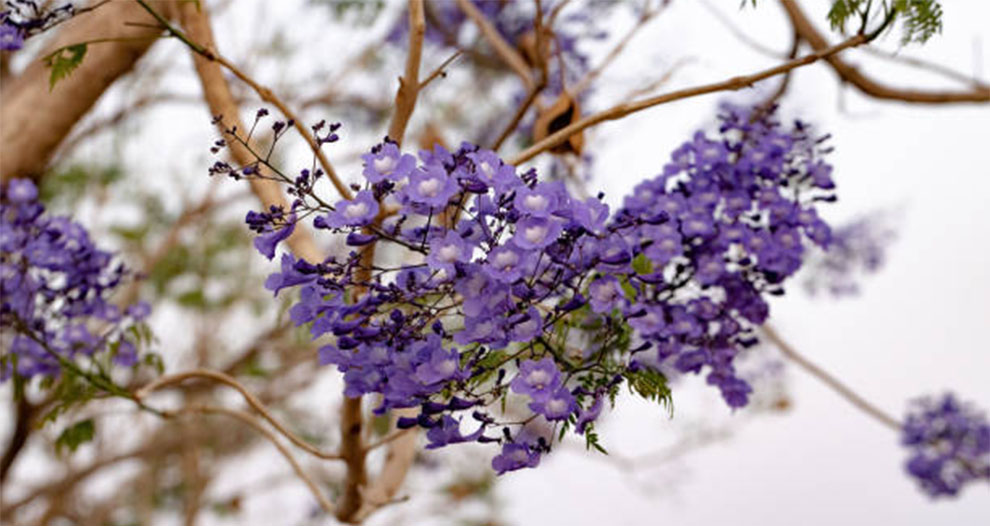
The dwarf bonsai blue jacaranda is a charming little tree to add to any type of landscape. It is a fast-growing jacaranda tree that produces wonderful blue flowers. Its mature height can go from 10 to 12 feet, while its mature spread is 6 to 8 feet wide. Besides its beautiful flowers, its deep green foliage also provides a stunning view of the gardens. These trees prefer to grow in hardness zones of 9 to 11.
2. Growth Rate of Blue Jacaranda Mimosifolia
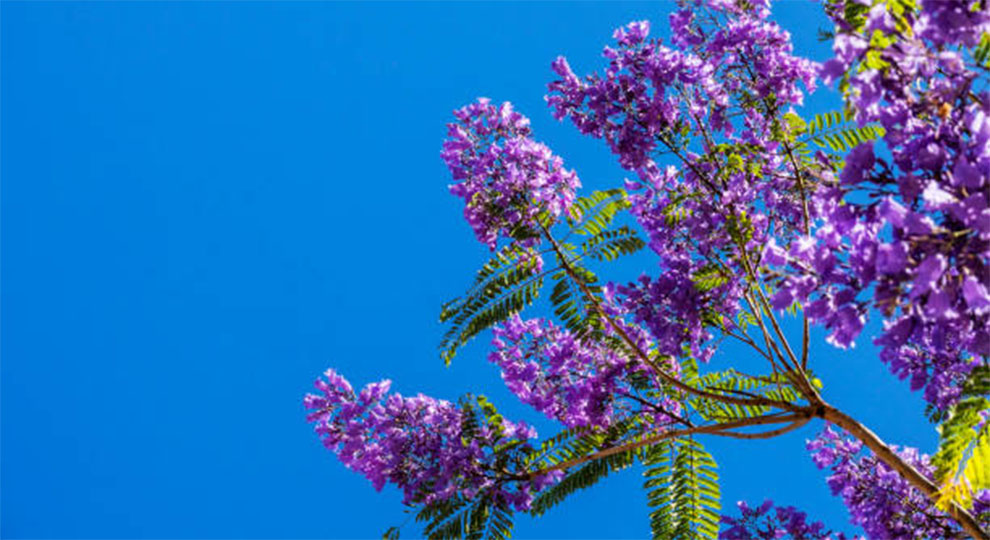
The stunning blue jacaranda is recognized for its highly attractive appearance. These trees have an upright branching system with a habit of spreading. Apart from this, the tree is beloved for its remarkable growth rate of 3-4 feet per year.
It reaches a height of about 25 to 50 feet and spread of 15 to 30 feet. These semi-evergreen trees can thrive in hardiness zones 4 to 9.
3. Jacaranda Jasminoides ‘Maroon’ Growth Rate
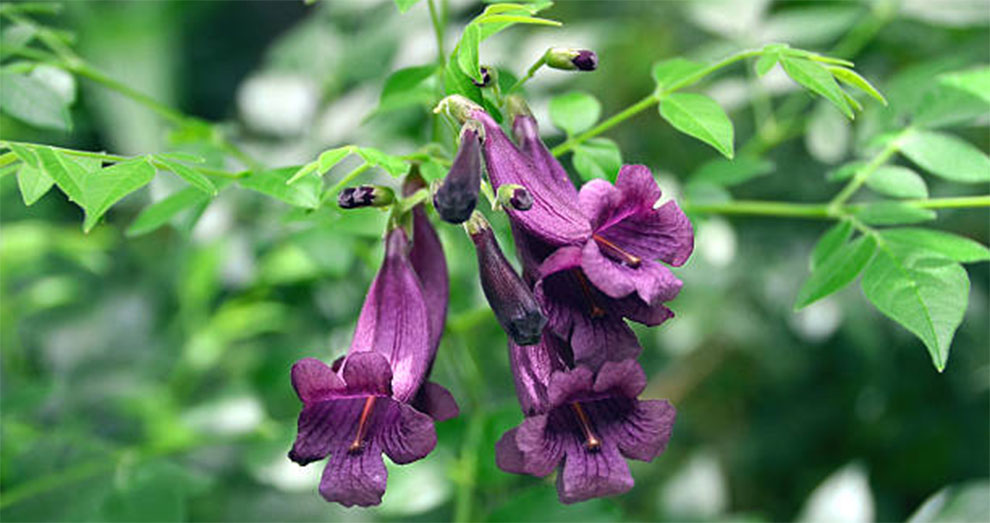
The ‘maroon’ jacaranda jasminoides are the most unique trees in the jacaranda family. These small trees are also fast growing and can reach a height of 10 to 25 feet. It can be an evergreen or deciduous tree identifiable with its stunning maroon and purple-shaded flowers. These trees will thrive well when grown under optimal conditions in a greenhouse or bright sunlight.
4. Yellow Jacaranda Growth Rate
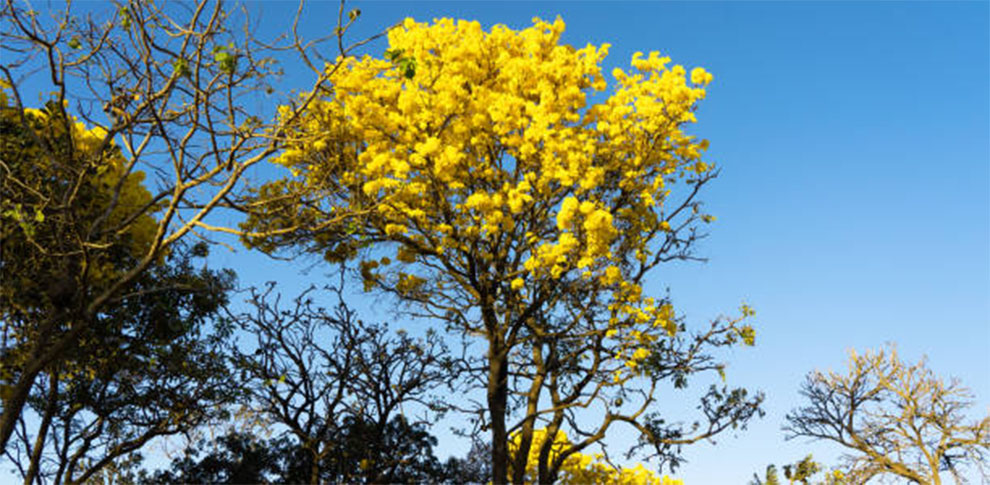
This is another pretty notable variety of jacaranda trees. The yellow jacaranda tree is known for its thin bark with a smooth texture and brown-grey color. It can grow to a mature height of 50 feet. The growth rate of yellow jacaranda is also fast but it is fairly dependent on prominent factors like temperature, sunlight exposure, soil type, and more.
How Can I Make My Jacaranda Grow Faster?
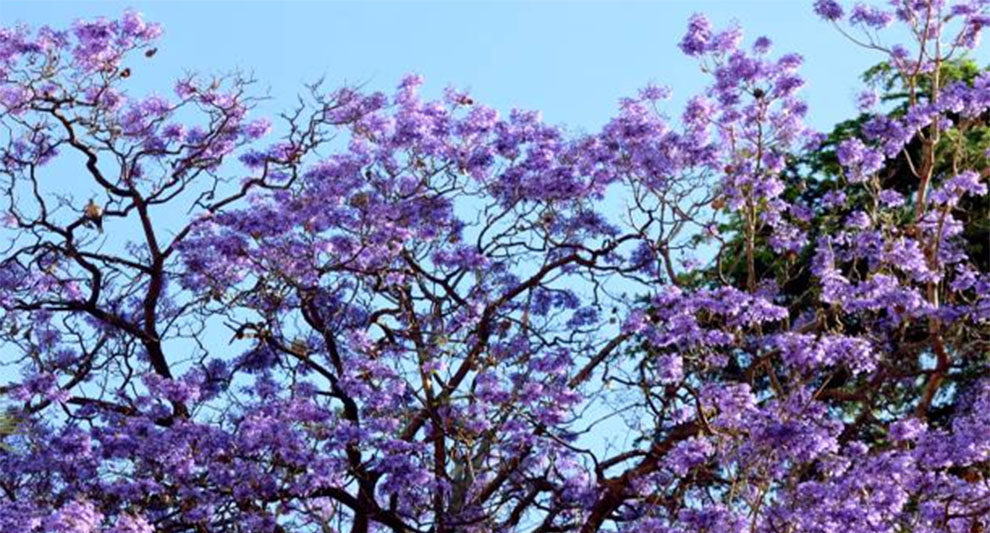
Jacaranda trees are highly popular for their trendy varieties. These tropical trees are liked for their wonderful perfumed purple flowers which appear like a trumpet. Usually, jacaranda trees grow best when planted outdoors.
On the other hand, when grown indoors these trees generally don’t produce flowers. If you want to make your jacaranda tree grow quickly, you should avoid planting it in a container. Typically, the jacaranda tree growth rate is dependent on a few key factors. Here check them out.
1. Soil type
These stunning trees are selective about the type of soil. Normally, they grow perfectly well in slightly sandy, acidic, and well-drained soil. If you want to avoid any symptoms of the damage, avoid planting your tree in wet, heavy, or dry soil conditions. Also, remember it can survive in loamy and clay soils as well. Although these trees like moisture-rich soil, but avoid waterlogging soil. Or else, it can cause severe problems like mushroom root rot and rotting roots.
2. Water
Jacaranda varieties indeed survive best in consistently moist soils. However, it should not get waterlogged. The best way to maintain optimum moisture in your plant soil is to apply root mulch. In hot and extremely dry conditions, you should consistently water your tree throughout the year. Avoid watering your tree as it enters the dormant state.
3. Light
Jacaranda trees bloom best when placed in full sunlight. It should get at least 6 to 8 hours of sunlight every day. When it comes to small jacaranda varieties, they can grow in light sunlight, but insufficient exposure to the sun can affect their flowering.
4. Fertilizer
Apply the best quality fertilizer for a healthy jacaranda growth. However, avoid using fertilizers that are highly rich in nitrogen because it can impact the quality of their blooms. As a general rule, the perfect NPK (nitrogen, phosphorus, potassium) fertilizer ratio for jacaranda trees should be 10-10-10 NPK.
5. Temperature and Humidity
Frequent temperature changes can often affect the growth of the jacaranda tree. Sometimes these trees can tolerate cold days with a temperature of 20 degrees Fahrenheit. But normally it is not preferred to grow these varieties in highly freezing conditions. So, carefully select a site that receives the optimal amount of humidity and sunlight.
Does Plant Spacing Also Affect Jacaranda’s Growth Rate?
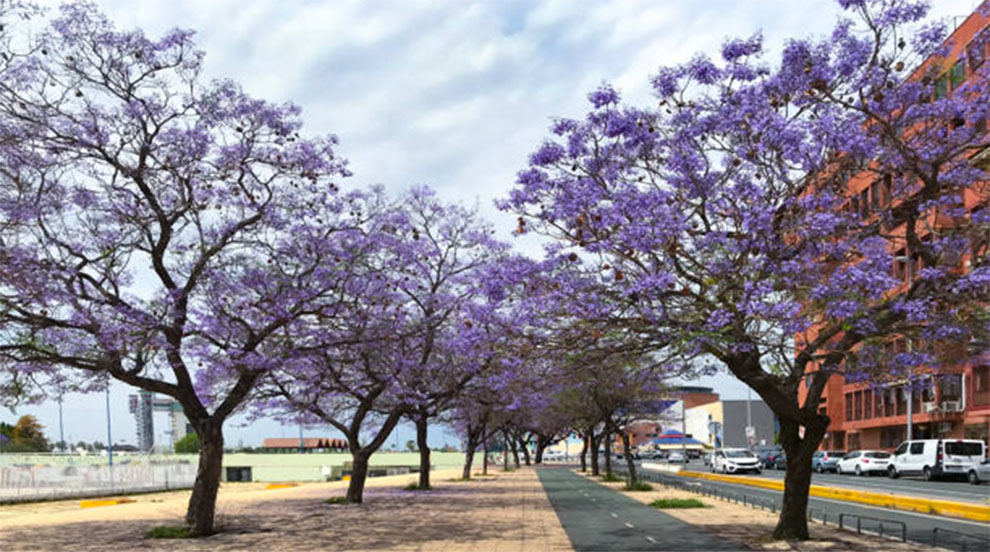
When it comes to a young jacaranda tree, is commonly planted in a container. The worst part about it is that your young tree might not flower when kept in a container. Just take care to replant your tree outside in the garden or yard.
Just like most fast-growing trees, jacaranda varieties can become weak during tropical storms or hurricanes. In such severe situations, its roots and branches are highly susceptible to breakdown. So, while planting any type of jacaranda tree, it’s necessary to place them carefully with enough spacing.
In general, you should place a jacaranda tree at least 15 – 20 feet away from your house’s exterior wall. That way your garden will be able to easily accommodate your tree irrespective of its spread and length.
In situations like heavy winds or storms, you can protect your home from any damage caused by breaking and falling branches. Likewise, plant your trees at a distance of 15 feet or more from your driveways or walks.
How To Keep A Jacaranda Tree Small?
If you want to maintain your jacaranda tree to a small size, take care to prune it every 2-3 years. It will help you to get rid of any unwanted branches and keep only the main trunk. While removing the branches, make sure to cut outside the collar, it will help with the quick healing of the wound.
However, if you don’t do timely pruning, it will lead to a heavier canopy and weaken the trunk of the tree. So, pruning your jacaranda tree from time to time will also improve the overall structure of the tree.
How Long Does It Take To Grow Jacaranda?
Keeping in mind how fast does a jacaranda tree grows, it will take around 6-7 years for it to show its first blooms. This is when it is planted from cuttings. Jacaranda trees have a long lifespan with elegant flowers.
When you take care of jacaranda under the right conditions, you can see it gaining a height of 15 to 25 m in about 20 years.
